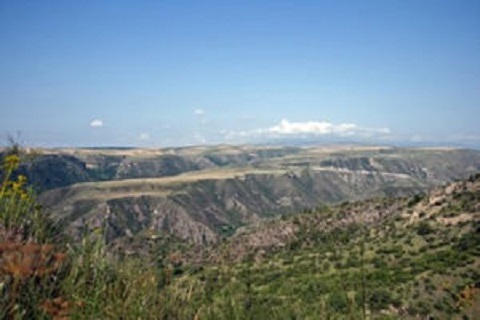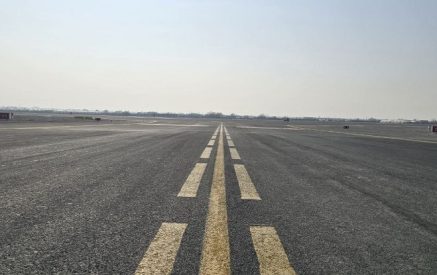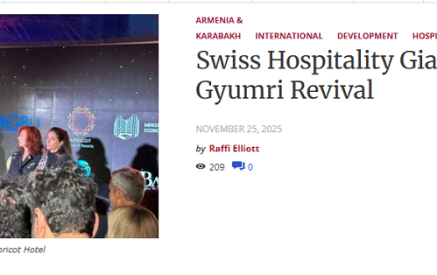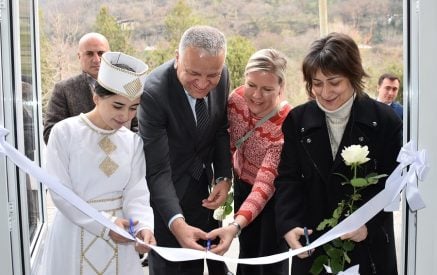The recent Azerbaijani border line encroachment towards Syunik should not surprise us at all. Azerbaijani President Ilham Aliyev’s threats after the war over Artsakh to forcibly open a “corridor” connecting Azerbaijan to its Nakhichevan exclave via Syunik, the role of Azerbaijani media in mobilizing its people for the “cause of Zangezur corridor,” and spreading the narrative of Zangezur being “Azerbaijani ancestral land” all fall within the context of the recent escalation.
Background of the Conflict
On May 12, 2021, no less than 400 Azerbaijani soldiers crossed several kilometers into Armenia in the provinces of Gegharkunik and Syunik. They invaded Lake Sev, which is located to the east of the village of Ishkhanasar and mountain Mets Ishkhanasar in the Syunik province; they also stationed themselves near the villages of Verin Shorzha and Kut in the Gegharkunik province (taking control of dominant hills). Despite the fact that Soviet maps state that only 30-percent of Sev Lake belongs to Azerbaijan, Baku had occupied the entire lake. Meanwhile, Ishkhanasar (which is the highest peak in the area with an altitude of 3,550 meters) is of strategic importance for Azerbaijan; by controlling the mountain and the surrounding area, Azerbaijan would have fire control over Syunik and Lachin Corridor. Hence, if another war erupts in the future, Azerbaijan would easily squeeze the supply routes towards Artsakh.
Read also
Azerbaijan’s appetite, however, seems perpetually unsatisfied. A week later, on May 20, Azerbaijani soldiers continued their advancement deep 1.5 kilometers in the direction of the village of Khoznavar in the Syunik region, as announced by head of the community Varo Grigoryan. “The Azerbaijanis invaded our territory. Now they are 2.5 km from the village,” Grigoryan said.
Internationally, the US, Canada and France expressed their concern over Azerbaijan’s violations and called for the withdrawal of Azerbaijani troops. Meanwhile, on May 20, the ambassadors of the Czech Republic, France, Germany, Italy, Lithuania, the Netherlands and Poland visited the Syunik region to show support to Armenia. However, as we all know, the real dealmaker in the South Caucasus has always been Russia.
The head of the Nagorno-Karabakh Russian peacekeepers Lieutenant-General Rustam Muradov took the initiative to mediate between both sides. Despite their promise, Azerbaijanis later refused to withdraw and negotiations failed. Moreover, on May 16 some Russian forces from the 102nd Russian military base in Gyumri were relocated to the bordering villages in Syunik and Gegharkunik. Russia’s military set up two new military sites in southern Armenia near the Azerbaijani border as an “additional security guarantee” based on acting PM Nikol Pashinyan’s request. Russia also announced that it will allocate $3.2 million from its budget for the reconstruction of certain regions in Armenia, most likely to rebuild the infrastructure and supply routes in bordering villages where Russian military posts are based.
However, Baku continues to test Armenia. To increase the psychological pressure on the Armenian side, the Azerbaijani defense ministry just wrapped up military exercises with up to 15,000 military personnel, 300 tanks and other armored vehicles, 400 missiles and artillery systems of various caliber, multiple launch rocket systems, mortars and anti-tank weapons, 50 military aviation assets, as well as unmanned aerial vehicles for various purposes. The fact that Armenia didn’t choose a military solution until now may be related to the location of these troops along the border.
Another “Secret Agreement”?
On May 20, Armenia’s former ambassador to the Vatican Mikayel Minasian leaked a draft document that Armenia was going to sign with Russia and Azerbaijan regarding the demarcation of the Armenian-Azerbaijani border. The key factor of the agreement is the establishment of a joint commission between Armenia and Azerbaijan for border demarcation. Russia will mediate the talks and a commission meeting will be held on June 30, 2021. Meanwhile, Azerbaijani telegram channels and media outlets argued that the final agreement between Armenia and Azerbaijan might include the return/exchange of enclaves/exclaves by both countries. According to unofficial reports from Azerbaijan, Artsvashen was going to be returned to Armenia, while the Tigranashen enclave located in Ararat province and seven villages from the Gazakh region of Tavush were going to be returned to Azerbaijan. This is very dangerous because it blocks the international Armenian-Georgian highway. It is also an unrealistic and unnecessary step by Armenian authorities as Artsvashen has no border connection with Armenia, is populated by Azerbaijanis and surrounded by Azerbaijani villages. Moreover, if these villages in Tavush are returned to Azerbaijan, accessing them via Azerbaijan will be impossible without opening up the border. The July 2020 clashes over the Tavush region should have provided a hint of why it was important for the Armenian side to consolidate its military position in the region and deter any future Azerbaijani advancement.
The above-mentioned rumors have caused serious concern among many analysts; on May 20 caretaker PM Pashinyan spoke about the “exchange of territories with Azerbaijan.” During his speech in parliament, he recalled that “under the control of Armenia there are territories that were once part of Soviet Azerbaijan, and there are territories of Soviet Armenia that are now under the occupation of Azerbaijan.” In his words, these issues should be resolved with the help of the trilateral commission on the demarcation and delimitation of the borders of Armenia and Azerbaijan. Even though the majority of the MPs voted against the draft, Pashinyan promised to sign the agreement. With this in mind, it is important to note that according to article 205 of the Constitution “any territorial changes of the Republic of Armenia shall be resolved through referenda.”
To put some pressure on Azerbaijan, on May 13 Armenia officially applied to the Collective Security Treaty Organization (CSTO), a Russia-led military alliance of six former Soviet states, under Article 2 categorizing the Azerbaijani border-line encroachments to Armenian territory as a “threat against the state” and not an “attack against attack” as labeled in Article 4 of the CSTO constitution. This was a gamble by Pashinyan, who knew well that the CSTO was not going to act as some of the member states have good relations with Azerbaijan. Thus CSTO’s unwillingness to act in Armenia’s favor was going to show the institution’s vulnerability and disunity, something that would put Russia in a difficult position. CSTO member states such as Kazakhstan and Kyrgyzstan have cultural and energy relations with Azerbaijan, while Belarus considers itself closer to Azerbaijan than Armenia. Azerbaijan and Belarus just signed an agreement, and back in 2018, Belarus sold Azerbaijan a batch of weapons including the Polonez multiple launch rocket system which was used against a CSTO member state during the 2020 Artsakh War.
Knowing CSTO’s inability to interfere in the border crisis, Azerbaijan has been downplaying Armenian reports. After eight days, its Foreign Minister responded to Armenia’s claims as “provocative” and recommended that political and military circles of Armenia not panic and aggravate the situation in the region. Meanwhile, President Aliyev once again stated that Baku is ready to carry out trade relations with Yerevan, but only if the Armenian side recognizes Karabakh as an inseparable part of Azerbaijan—something that would shake Russia’s position in Nagorno-Karabakh since the recognition of Nagorno-Karabakh as part of Azerbaijan by Armenia would make Russia’s presence in the region meaningless and solve the conflict in favor of Azerbaijan.
When Geo-Economics and Geopolitics Intertwine
Iran is one of the regional powers actively concerned with the developments in Syunik. Tehran’s response to the Azerbaijani border-line encroachments in Syunik was harsh and clear. The Armenian-Iranian relations are based on convergent geopolitical interests. Economic cooperation with Iran is vital to Armenia, while Tehran may use Armenia as an economic route opening to European markets. As stated in my analysis four months ago, Iran had limited options during the 2020 Artsakh War and lost its geopolitical leverage on the South Caucasus. Thus any change regarding the internationally recognized borders with Armenia or a de facto loss of Armenian sovereignty over Syunik (bordering Iran) would threaten Iran’s national security and place Iran at the mercy of Turkey and Azerbaijan when it comes to trade routes linking Tehran to Russia and Europe. Moreover, this factor would further instigate pan-Azeri/Turkic nationalism in the region.
Dr. Mojtaba Zolanuri, chairman of the National Security and Foreign Policy Committee of the Iranian Parliament, recently commented on Azerbaijan’s infiltration into Armenia and highlighted Iran’s position. Dr. Zolanuri said that the position of the Islamic Republic of Iran is very clear and decisive. “We do not accept any territorial change in the region,” said Dr. Zolanuri, “The territorial integrity of the countries of the region must be preserved. We also do not accept any supra-regional power near our borders. If a part of the territory of Armenia is to be taken, the border conditions are changed, that is, we have a new problem, it is not acceptable for us.” Iranian Telegram channels also claim that Iran is dissatisfied with Pashinyan’s signing of a new “agreement” with Russia and Azerbaijan over the “border conflict” between Yerevan and Baku. On May 18, Iranian reconnaissance aircraft were reportedly monitoring the Armenian-Azerbaijani border.
Economically speaking, according to Iranian Fars News Agency, on May 15, Chairman of Iran-Armenia Joint Chamber of Commerce Hervik Yarijanian said that the Meghri free trade zone will be opened soon in the Aras region in northwestern Iran which can boost the volume of trade between Iran and Armenia up to $1 billion. This was another message sent by Iran to Azerbaijan signaling Syunik’s geo-economic importance for Tehran. Meeting with Iran’s Minister of Roads and Urban Development Mohammad Eslami on May 17, the Armenian ambassador in Tehran Artashes Tumanyan said Yerevan also counts on Iran’s support in the border standoff. Eslami reaffirmed to the ambassador his country’s support for Armenia’s territorial integrity. In that context, he assured Tumanyan that Tehran remains committed to the idea of creating a “transport corridor” that would connect Iran’s Persian Gulf ports to the Black Sea through Armenia and Georgia. During a March visit to Yerevan, Iranian Foreign Minister Mohammad Javad Zarif described Armenia’s territorial integrity as a “red line” for Iran.
It was within this context that India joined Iran and sent a harsh diplomatic message to Azerbaijan. India called on Azerbaijan to pull back its forces from Armenia “immediately” and refrain from further provocation. Arindam Bagchi, the spokesperson of the Ministry of External Affairs of India, stated that India has been following, with concern, the situation along the Armenia-Azerbaijan border. The senior diplomat added that “peace and stability in the South Caucasus region are important from the regional security perspective.” From the Indian perspective, any military conflict in southern Armenia may threaten the security of the International North-South Transport Corridor where both India and Iran are encouraging Armenia to play a bridging role connecting the Persian Gulf to the Black Sea.
Basically, what can Azerbaijan achieve with this provocative move? If Azerbaijan annexes the seven villages in Tavush that were once under the jurisdiction of Soviet Azerbaijan, it will be controlling all the international highways of Armenia. According to the November 9 trilateral statement, Azerbaijan will be providing a transport link for Armenia (through Nakhichevan, though the region is not mentioned). Thus already, if implemented, Azerbaijan will be controlling the trade activities along the Armenian-Iranian border. The trilateral statement also mentions that Armenia will be providing a “transport link” to Azerbaijan (probably via Syunik) but will be guarded by Russian border troops, and Russia (not Armenia) will exercise control over the transport communication. Now if the border demarcation “agreement” is signed, Azerbaijan would start publicly demanding the annexation of the seven former Soviet Azerbaijani exclaves in Tavush, thus aiming to control the Georgia-Armenia highway. Armenia’s trade activities would be fully dependent on Azerbaijan’s policy toward Armenia. This would be one of the factors for pushing Azerbaijan to launch small-scale military actions on Syunik to impose its political will over Armenia, knowing the fact that acting PM Pashinyan will sign any deal to secure his political future.
A junior diplomatic source from Iran (who requested his identity be kept anonymous) highlighted that Azerbaijan’s actions may be related to Armenia’s participation in the “International North-South Corridor.” The source has stated that next month Iran officially will start negotiations with the Eurasian Economic Union (EEU) to process its full membership application. Armenia is the main negotiator in support of Iran’s full membership. The diplomat believes that this conflict is directly related to India’s initiative of the trade corridor where New Delhi and Tehran are encouraging Yerevan to become a link connecting India and the Persian Gulf to the Black Sea (through Georgia). Azerbaijan is not pleased with this initiative and may destabilize Syunik, and Armenia in general, to distract Armenia and show Yerevan as a non-reliable partner. Therefore, Syunik—the backbone of Armenia with its geostrategic location along trade routes—may determine the geo-economic future of not just Armenia, but the entire region.
Yeghia Tashjian
Main Photo Caption: The mountain plateaus of Syunik, viewed from Berdzor (Lachin) (Photo: Former Weekly editor Antranig Kasbarian, Oct. 2020)

























































